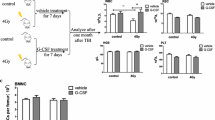Abstract
Ionizing radiation can damage the hematopoietic system, and treatment with cytokines, including granulocytecolony-stimulating factor (G-CSF), is used to enhance hematopoietic recovery. In the present study, mice were whole-body irradiated with a sublethal dose of 5 Gy to produce severe myelosuppression and to evaluate the hematologic consequences of G-CSF treatment following irradiation. G-CSF (100 μg/kg of body weight) was injected immediately after irradiation, and then every three days for 3 weeks. G-CSF significantly ameliorated the decrease in peripheral neutrophils typically observed after exposure to radiation, but it also aggravated the decrease in the number of peripheral platelets during days 3–14 following irradiation. In the histological analysis, while the number of megakaryocytes was significantly decreased in the bone marrow, a number of trapped megakaryocytes were observed in the spleen of G-CSF-treated and irradiated mice. These data suggest that radiation-induced thrombocytopenia is worsened by G-CSF administration, possibly due to a decrease in the number of megakaryocytes in the bone marrow and an increase in the trap** of megakaryocytes in the spleen.
Similar content being viewed by others
References
Waselenko, J. K. et al. Medical management of the acute radiation syndrome: recommendations of the Strategic National Stockpile Radiation Working Group. Ann Intern Med 140:1037–1051 (2004).
Dainiak, N. Hematologic consequences of exposure to ionizing radiation. Exp Hematol 30:513–528 (2002).
Fliedner, T. M., Nothdurft, W., & Heit, H. in Response of Different Species to Total Body Irradiation Vol. 10 Series in Radiology Ch. 14, 209–219 (Springer Netherlands, 1984).
Martinez, C., Urbano-Ispizua, A., Mazzara, R., Rozman, C., & Montserrat, E. Granulocyte colony-stimulating factor administration and peripheral blood progenitor cells collection in normal donors: analysis of leukapheresis-related side effects. Blood 87:4916–4917 (1996).
Clark, S. C., & Kamen, R. The human hematopoietic colony-stimulating factors. Science 236:1229–1237 (1987).
Singh, V. K., Shafran, R. L., Inal, C. E., & Jackson, W. E., 3rd & Whitnall, M. H. Effects of whole-body gamma irradiation and 5-androstenediol administration on serum G-CSF. Immunopharmacol Immunotoxicol 27:521–534 (2005).
Dainiak, N., Waselenko, J. K., Armitage, J. O., Mac-Vittie, T. J., & Farese, A. M. The hematologist and radiation casualties. Hematology Am Soc Hematol Educ Program:473–496 (2003).
MacVittie, T. J., & Farese, A. M. Cytokine-based treatment of radiation injury: potential benefits after low-level radiation exposure. Mil Med 167:68–70 (2002).
Dainiak, N. Rationale and recommendations for treatment of radiation injury with cytokines. Health Phys 98:838–842 (2010).
Kim, J. S. et al. Granulocyte-colony stimulating factor ameliorates irradiation-induced suppression of hippocampal neurogenesis in adult mice. Neurosci Lett 486:43–46 (2010).
Kim, J. et al. Protection of spermatogenesis against gamma ray-induced damage by granulocyte colony-stimulating factor in mice. Andrologia 43:87–93 (2011).
Kim, J. S. et al. Attenuating effects of granulocyte-colony stimulating factor (G-CSF) in radiation induced intestinal injury in mice. Food Chem Toxicol 50:3174–3180 (2012).
Kim, J. S. et al. In vitro and in vivo protective effects of granulocyte colony-stimulating factor against radiation-induced intestinal injury. Arch Pharm Res 36:1252–1261 (2013).
Takamatsu, Y. et al. Thrombocytopenia in association with splenomegaly during granulocyte-colony-stimulating factor treatment in mice is not caused by hypersplenism and is resolved spontaneously. Transfusion 47:41–49 (2007).
MacVittie, T. J. et al. Combination therapy for radiation-induced bone marrow aplasia in nonhuman primates using synthokine SC-55494 and recombinant human granulocyte colony-stimulating factor. Blood 87:4129–4135 (1996).
Van der Meeren, A., Mouthon, M. A., Vandamme, M., Squiban, C., & Aigueperse, J. Combinations of cytokines promote survival of mice and limit acute radiation damage in concert with amelioration of vascular damage. Radiat Res 161:549–559 (2004).
Uckun, F. M., Souza, L., Waddick, K. G., Wick, M., & Song, C. W. In vivo radioprotective effects of recombinant human granulocyte colony-stimulating factor in lethally irradiated mice. Blood 75:638–645 (1990).
Herodin, F., & Drouet, M. Cytokine-based treatment of accidentally irradiated victims and new approaches. Exp Hematol 33:1071–1080 (2005).
Kovacic, J. C. et al. Profound thrombocytopenia related to G-CSF. Am J Hematol 82:229–230 (2007).
Akizuki, S., Mizorogi, F., Inoue, T., Sudo, K., & Ohnishi, A. Pharmacokinetics and adverse events following 5-day repeated administration of lenograstim, a recombinant human granulocyte colony-stimulating factor, in healthy subjects. Bone Marrow Transplant 26:939–946 (2000).
Platzbecker, U. et al. Spleen enlargement in healthy donors during G-CSF mobilization of PBPCs. Transfusion 41:184–189 (2001).
Falzetti, F., Aversa, F., Minelli, O., & Tabilio, A. Spontaneous rupture of spleen during peripheral blood stemcell mobilisation in a healthy donor. Lancet 353:555 (1999).
Matsumura, G., Sasaki, K., & Ito, T. Quantitative observation of megakaryocytes in the spleen and bone marrow of the mouse: effects of sex, sex hormones, pregnancy and lactation. Arch Histol Jpn 47:251–258 (1984).
Author information
Authors and Affiliations
Corresponding author
Additional information
These authors equally contributed to this work
Rights and permissions
About this article
Cite this article
Son, Y., Bae, M.J., Lee, C.G. et al. Treatment with granulocyte colony-stimulating factor aggravates thrombocytopenia in irradiated mice. Mol. Cell. Toxicol. 10, 311–317 (2014). https://doi.org/10.1007/s13273-014-0035-6
Received:
Accepted:
Published:
Issue Date:
DOI: https://doi.org/10.1007/s13273-014-0035-6




